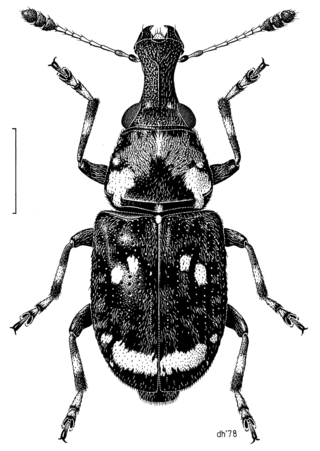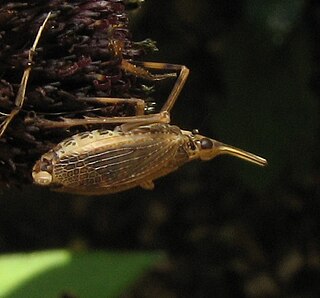
The Micropezidae are a moderate-sized family of acalyptrate muscoid flies in the insect order Diptera, comprising about 500 species in about 50 genera and five subfamilies worldwide,. They are most diverse in tropical and subtropical habitats, especially in the Neotropical Region.

Anthribidae is a family of beetles also known as fungus weevils. The antennae are not elbowed, may occasionally be longer than the body and thread-like, and can be the longest of any members of Curculionoidea. As in the Nemonychidae, the labrum appears as a separate segment to the clypeus, and the maxillary palps are long and projecting.
Abnormipterus is a monotypic moth genus in the erebid subfamily Arctiinae described by Orfila in 1935. Its single species, Abnormipterus abnormis, was first described by George Hampson in 1898. It is found in the lower Amazon River basin.
Mestolobes abnormis is a moth of the family Crambidae described by Arthur Gardiner Butler in 1882. It is endemic to the Hawaiian island of Oahu.

Cepora abnormis, the Papuan gull, is a species of butterfly in the family Pieridae found in Indonesia.

Hybridoneura abnormis is a moth in the family Geometridae. It is found in the north-eastern Himalayas, Sri Lanka, Sundaland and on Sulawesi. The habitat consists of mixed dipterocarp forests, as well as lower montane forests.

Phyllanthus abnormis, known as Drummond's leafflower, is an herbaceous plant in the family Phyllanthaceae. It grows from 10 to 50 centimeters in height. It is native to the United States and Mexico (Tamaulipas). Throughout its range, it is always found growing in sand or sandy soil.

Micropeza corrigiolata is a species of stilt-legged flies in the family Micropezidae.

Micropeza is a genus of stilt-legged flies in the family Micropezidae.
Cylloepus abnormis is a species of riffle beetle in the family Elmidae. It is found in Central America and North America.

Cylloepus is a genus of riffle beetles in the family Elmidae. There are about six described species in Cylloepus.

Pedilus is a genus of fire-colored beetles in the family Pyrochroidae. There are at least 20 described species in Pedilus.

Scolops is a North American genus of dictyopharid planthoppers in the subfamily Dictyopharinae. There are over 30 described species in the genus Scolops.

Acroneuria abnormis, the common stone, is a species of common stonefly in the family Perlidae. It is found in North America.
Zeugophora abnormis is a species of megalopodid leaf beetle in the family Megalopodidae. It is found in North America.
Micropeza stigmatica is a species of stilt-legged flies in the family Micropezidae.
Micropeza nitidor is a species of stilt-legged flies in the family Micropezidae.

Micropeza lineata is a species of stilt-legged flies in the family Micropezidae.
Phintella abnormis is a spider species of the family Salticidae.

Trigonopterus abnormis is a species of flightless weevil in the genus Trigonopterus from Indonesia.











